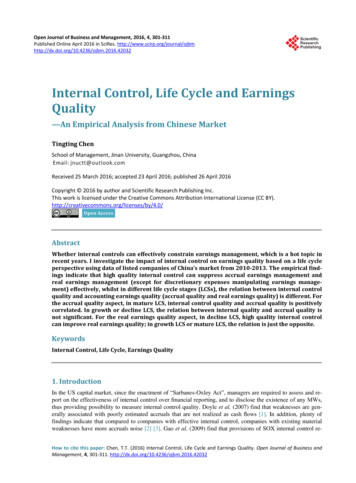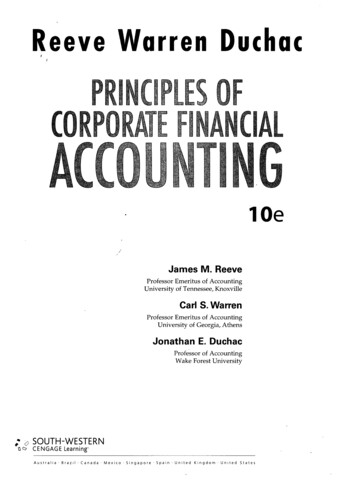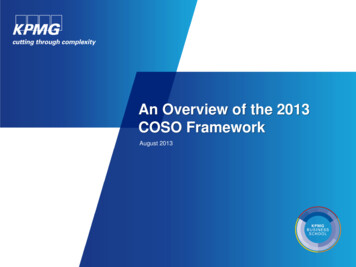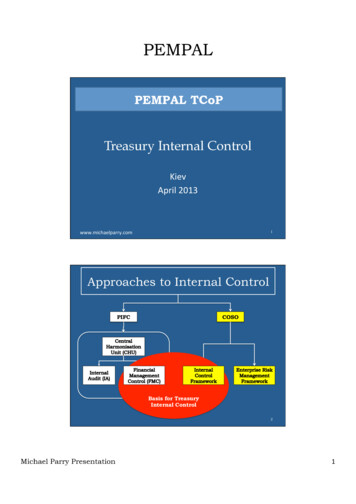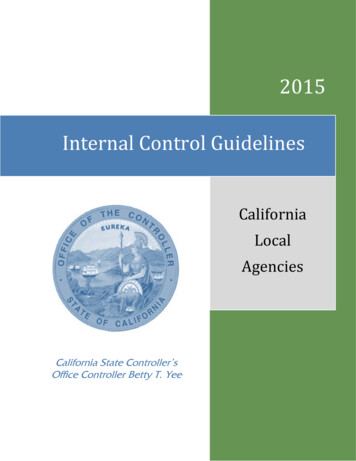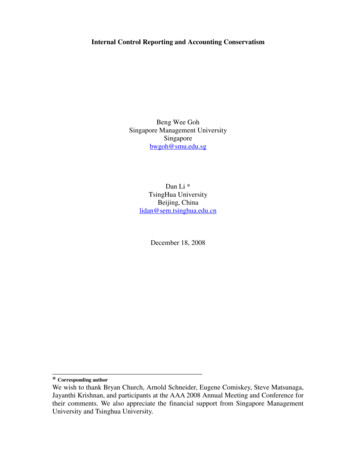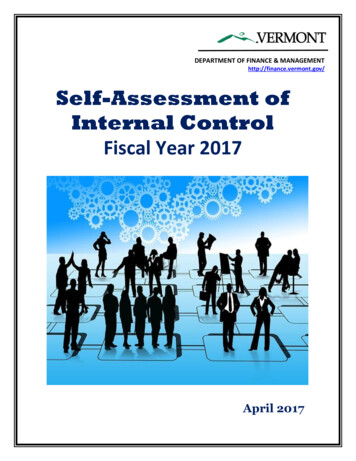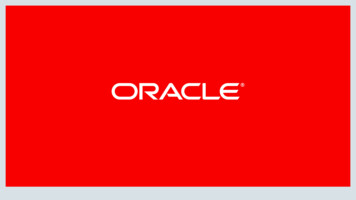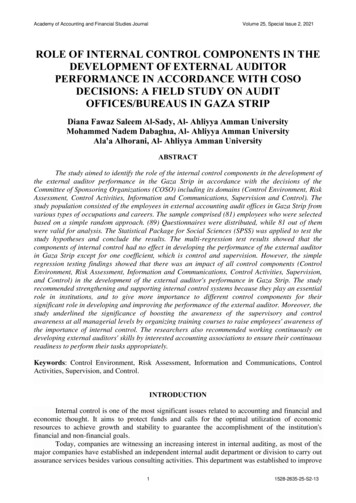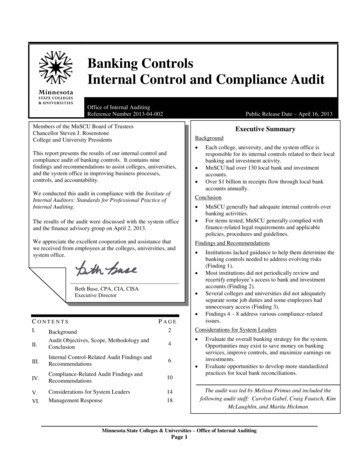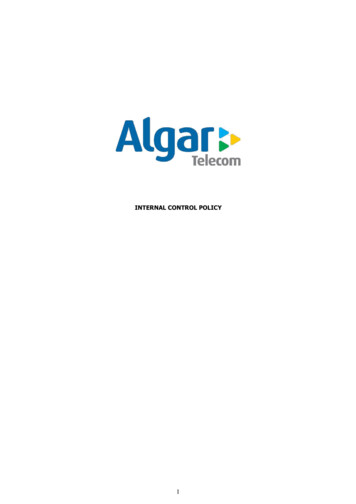
Transcription
INTERNAL CONTROL POLICY1SP - 21073245v1
TABLE OF CONTENTS1. Objective . 32. Responsibility . 33. Reference . 34. Definitions . 35. Roles and Responsibilities . 46. Internal Controls Documentation . .57. Self-Assessment of Internal Controls . .58. Independent Assessment of Internal Controls . .59. Action Plan . .610. Term . .611. Approval . .62SP - 21073245v1
1.OBJECTIVEThis document aims to establish the guidelines for the assessment of internal control, consideringthe main operational processes of Algar Telecom S.A. and its direct and indirect subsidiaries("Company"), focusing on the disclosure of financial reports and operations efficiency. Theseguidelines are complemented, when applicable, by specific business rules and procedures, whichare fully disclosed and available to all members of the Company.2.RESPONSIBILITYThe responsible areas are: Risk Management and Internal Controls, Internal Audit and Companycoordinators whose business processes are part of the scope of the periodic assessment ofinternal controls.3.REFERENCEThis Policy is based on (i) the corporate governance guidelines of the Company's Bylaws, asamended; (ii) the applicable rules issued by the Brazilian Securities and Exchange Commission("CVM"); (iii) the Novo Mercado Listing Regulation issued by B3 S.A. – Brasil, Bolsa, Balcão approvedby the CVM Board on September 5, 2017; (iv) the COSO-ERM model - Committee of SponsoringOrganizations of the Treadway Commission (COSO ERM); (v) Federal Law 11,846 – Anti-Corruptionand Policy for Relationship with Government Entities; and (vi) the Risk Management Policy, whoseadoption was approved by the Company's Board of Directors.4.DEFINITIONS4.1. “Internal controls": According to the COSO ERM model, internal control is defined as aprocess that is executed by the Company's senior management, managers or other personsassociated with the Company, and considers policies, procedures, activities and mechanisms thatare aimed at providing a significant degree of reliability on the following objectives: Effectivenessand efficiency of resources; Reliability of the financial information; Compliance with establishedlaws and regulations.4.2. “COSO-ERM” (Committee of Sponsoring Organizations of Treadway Commission) is theinternational model for internal controls and is consists of five components: Control Environment,Risk Assessment, Control Activities, Information and Communication, and Monitoring Activities4.3. “Business Process”: A succession of clearly defined activities with at least one initial stepand one final step.4.4. “Risk”: Any and all events arising from uncertainties to which the Company is exposed andwhich may negatively impact the objectives and value generation.4.5. "Types of Controls": The internal controls of the business processes can be classified asPreventive (executed at the beginning of the process - prevents the occurrence of errors orirregularities and minimizes the risks at the source) and Detective (executed throughout theprocess, detecting errors which are difficult to define or predict). They can also be classified asManual (performed through conferences or procedures by a person), Automatic (validationsperformed by systems with little or no human interference) or Manual IT dependent (proceduresperformed by people based on the use of information or actions deriving from technologicalsystems)4.6. "Control Execution Frequency": The control execution frequency defines the number oftimes a control is executed. The frequency can be classified into: recurring (several times a day),daily, weekly, monthly, quarterly, semi-annual, annual and per event (when there is no specificfrequency).3SP - 21073245v1
4.7. "Compensatory Controls": Compensatory controls are intended to mitigate losses orexposure to risks in situations where a particular control activity is no capable of achieving thecontrol objectives of a particular process. Compensatory controls do not replace control activitiesaddressed in business processes. They only minimize the occurrence of errors, fraud or losses thatwould not be prevented and/or detected in the absence of such controls.4.8. "Control Deficiency": Failure to execute a control that individually or together with otherfailures would clearly result in immaterial distortions in financial statements or immaterial financialloss.4.9. "Significant Deficiency": A deficiency of control, or a combination of deficiencies, thatresults in a possible probability of not preventing or detecting material misstatements in financialstatements or material financial loss.5.ROLES AND RESPONSIBILITIES5.1. Audit and Risk Management Committee: (a) reviews and evaluates the adequacy of theinternal control assessment plan, including the scopes for process, methodology, strategy and itscomprehensiveness; (b) takes recognition of the control deficiencies identified within theCompany's internal control environment; (c) monitors the implementation of the action plans whenapplicable; and (d) informs the Board of Directors on significant deficiencies and actions takentowards them.5.2. Senior Management: (a) periodically monitors the evolution of the internal control assessmentaccording to the reports issued by the Risk Management and Internal Control, Internal Audit andIndependent Audit coordination teams; (b) ensures the implementation of actions defined by thecoordinators subordinated to them in relation to the implementation/adequacy of internal controls;and (c) sponsors improvements to the internal control environment, always seeking a balanceamong the effectiveness of the processes, controls and costs, as well as the alignment with theCompany's strategic objectives.5.3. Risk and Internal Control Coordination: (a) assists the business areas in theidentification/implementation/adequacy of internal controls, documentation of internal controls; (b)identifies the need to implement new controls and/or the need for improvement in existingcontrols when the absence and/or insufficiency of these result in significant deficiencies; (c)manages the self-assessment steps of the internal controls; (d) reviews/evaluates the action plansindicated by the business areas in relation to meeting the objectives of internal controls, mitigationof risks and implementation deadlines; e) monitors the independent assessments of internalcontrols performed by the Internal Audit and Independent Auditors; f) is subordinate to theFinancial Division.5.4. Coordinators and Teams responsible for internal controls: (a) self-assess the processes undertheir responsibility during a period pre-determined by the Risk and Internal Control Coordination;(b) ensure the execution of existing internal controls according to architecture and frequency,implement new internal controls and improvements to existing internal controls; and (c) report anychanges in the internal controls structures through changes in business (processes, people,systems) in a timely manner.5.5. Internal Audit: (a) independently evaluates the efficiency and effectiveness of internalcontrols; (b) recommends the implementation of new internal controls and/or improvements inexisting internal controls, when the absence and/or insufficiency of these result in significantdeficiencies; (c) reports deficiencies in internal controls to Senior Management and the Audit andRisk Management Committee; (d) follows the recommendations of the independent auditors; and(e) monitors the implementation of action plans for identified internal control deficiencies.5.6. Strategic Risk Management, Risk and Internal Control Coordination, and Internal Audit: a)interact with the business areas for the annual planning efforts in order to guarantee accuracy,efficiency and effectiveness of the activities; b) share the assessment results carried out by each4SP - 21073245v1
business area, consolidating the works to be reported to Management, Audit Committee and RiskManagement.6.INTERNAL CONTROLS DOCUMENTATION6.1. The documentation of processes, risks and internal controls is carried out through the internalcontrols matrix, which is structured to guarantee the necessary information that supports theassessments of processes, systems and controls.6.2. The internal control matrix contains the following structure: process, sub-process, risk factor,control activity, frequency, responsibility, type of control (preventive/detective), nature of control(manual, automatic, manual IT dependent), relevance (key control) and the outcome of theevaluated effectiveness.6.3. The recordings of the internal control matrix must be updated by the Risk and InternalControl Coordination, according to the information received from the internal control officer,through changes in the business (processes, people, systems) or when change is identified in theself-assessment process of internal controls.7.SELF-ASSESSMENT OF INTERNAL CONTROLS7.1. The internal control’s self-assessment is the procedure in which the evaluation of processesand controls must be performed by the internal control officers assigned in the documents of theinternal controls matrix.7.2. The self-assessment is performed either through questionnaires or facilitated sessions toassess the adequacy of internal controls in mitigating risks and promoting compliance withobjectives.7.3. The self-assessment procedure should occur annually according to the schedule defined bythe Risk and Internal Control Coordination.7.4. During the self-assessment process, changes in internal controls architecture, inclusion ofnew controls and substitution/elimination of controls may be proposed by the respectivecontrollers, provided that it ensures reasonable assurance that all business objectives will be met.7.5. As an outcome of the self-assessment process, the internal control officers must assign thefollowing status: Implemented (for controls and processes that were implemented and areoperating properly as documented in the control matrix) or Not Implemented (for controls that arenot operating as described). The internal controls with a Not Implemented status should have ajustification in order to be assessed by the Risk and Internal Control Coordination.7.6. The results will be analyzed by the Risk and Internal Control Coordination and informed tothe Steering Committee.8. INDEPENDENT ASSESSMENT OF INTERNAL CONTROLS8.1. The assessment of internal controls is performed in two phases: assessment of control design(documentation and walkthrough) and assessment of operational effectiveness (control test).8.2. The assessment of the internal control architecture is performed annually to confirmunderstanding of transaction flow and process documentation.8.3. The assessment of the operational effectiveness is performed annually and the selection ofinternal controls to be tested is performed considering the following criteria: (a) relevance of thecontrol (key controls must be selected annually); (b) result of the effectiveness test from theprevious year (ineffective controls are selected); (c) impact on the financial statements (controls5SP - 21073245v1
listed in the scope of the Independent Auditors’ assessment are selected); (d) past selection ofcontrols in previous years (other controls are selected according to rotation so that they areassessed, at least, every 3 years).8.4. The Internal Audit carries out internal control tests according to the selection criteria above oraccording to the planned audit work for the year.8.5. The scope of internal control tests that have impact on the financial statements is jointlydefined with the Internal Audit and Independent Audit in order to guarantee work synergy. Thework carried out by the Independent Audit may use information provided by the Internal Audit toidentify material misstatement in the financial statements, and the Internal Audit may use thework performed by the Independent Audit to complement the assessment of the company'scontrol environment. This synergy does not eliminate the need for the independent auditor tostudy and evaluate the entity's accounting system and internal controls as a basis for determiningthe nature, timing and extent of the application of audit procedures, considering various aspects.8.6. The internal control testing procedures are documented in the work plan and must present:control information based on the internal control matrix, test procedure (inquiry, observation,inspection, reperformance or analytical procedures), selected samples, test results, completion ofcontrol (effective/ineffective), impact measured, responsible for the test and test date.8.7. The test sampling is randomly defined according to nature (manual, automatic, manual ITdependent) and control frequency.8.8. Ineffective internal controls are assessed in relation to their classification as significantdeficiency according to extent of impact on the financial statements or operations of the Company.8.9. The Independent Audit shares the result of the internal control test with the Internal Audit,consolidates the results and issues a recommendation letter to Management on identifiedimprovement opportunities for internal control according to the performed assessment.8.10. The result of the internal control tests is consolidated by the Internal Audit and presented toManagement and the Audit and Risk Management Committee.8.11. Management must annually report in the CVM (Brazilian Securities and ExchangeCommission) Reference Form the adequacy of the internal control environment based on theindependent assessment of the controls. Significant deficiencies impacting the Company's financialstatements and operations should be disclosed in the Reference Form.9.ACTION PLAN9.1. Internal controls assessed as ineffective are discussed with those responsible for theimplementation of the controls and the Coordination responsible for defining the action plan forcorrecting the identified deficiency.9.2. The Risk and Internal Control Coordination assists in the preparation and follow-up of theimplementation of the necessary action plans to implement or improve the internal controlsnecessary to mitigate risks.9.3. The status of the agreed action plan is reported to Management and to the Audit and RiskManagement Committee.10. TERM10.1. This Policy shall be enforced on the date of its approval and may only be modified byresolution from the Company's Board of Directors and may be viewed by corporativa/codigos-e-politicas, then selecting “InternalControl Policies”.6SP - 21073245v1
****7SP - 21073245v1
8.4. The Internal Audit carries out internal control tests according to the selection criteria above or according to the planned audit work for the year. 8.5. The scope of internal control tests that have impact on the financial statements is jointly defined with the Internal Audit and Independent Audit in order to guarantee work synergy. The
